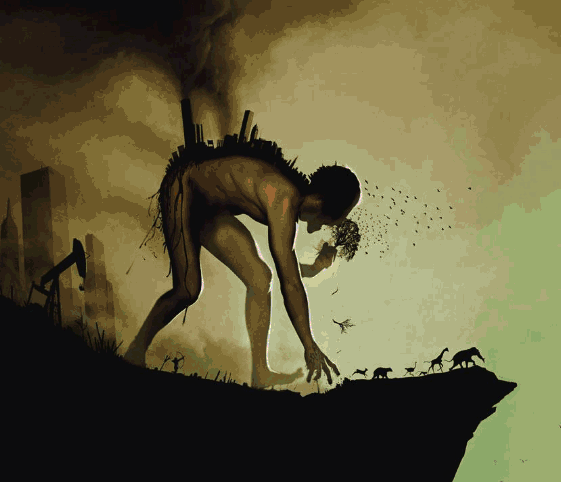 Overcast with thick, moist fog this Thursday morning on California’s north coast, and if you’ve seen NASA‘s ‘Blanket of Smoke‘ photo (if not, Lost Coast Outpost has it), then you understand the staying power of our saturated marine layer, leaving no room for sunshine.
Overcast with thick, moist fog this Thursday morning on California’s north coast, and if you’ve seen NASA‘s ‘Blanket of Smoke‘ photo (if not, Lost Coast Outpost has it), then you understand the staying power of our saturated marine layer, leaving no room for sunshine.
Or for heat — really chilly all day yesterday, although the NWS predicted high-end-60s, it was sweatshirt climate.
And with California’s drought-sponsored tales of forest fires, depleting water, brainiacs have finally officially pined the culprit’s tail on the donkey’s ass — climate change.
(Illustration found here).
Duh!
During this past four years of drought, experts have skirted around naming climate change as the real backbone of our current situation, some studies recently have swung that way, but now the ass is out of the bag.
Via Climate Central this morning:
One question that’s lingered as long as the drought itself is just how much, if any, of the drought is due to climate change.
New research has an answer: up to 27 percent.
It also has another important number: climate change has made the odds of severe droughts like this one twice as likely.
The sobering numbers come from researchers at the Lamont-Doherty Earth Observatory, NASA and University of Idaho who analyzed temperature, precipitation, wind speed and other data to tease out the role climate change has played in the drought in a new study published on Thursday in Geophysical Research Letters.
It’s the latest in a string of studies that have examined this big question.
The general consensus is that heat has played a role in exacerbating the drought and that at least some of that heat is part of the larger pattern of global warming.
Last year was a punctuation mark with record-setting heat baking the Golden State to crispy golden brown.
…
“This study is the first to parse out the relative contribution of anthropogenic warming versus natural climate variability,” Park Williams, a tree ring researcher at Lamont, said.
“From a method standpoint, it’s a big advancement. It’s the first time I know of that data has been parsed apart this way for any drought on the planet.”
Williams led the latest round of research that uses temperature, precipitation, wind and other drought data to break the state up into grid of 23,955 boxes.
The data paint the sharpest picture yet of a state in severe drought.
Averaged across the state, the findings show that this hasn’t been California’s worst drought on record, but it is the worst drought on record in the places that matter the most to people.
The epicenter of the drought is the Central Valley, the heart of California’s $46.4 billion agricultural industry.
The Sierra Nevada mountains, where most of the state’s water comes from, and a large swath of the coast from San Diego to San Francisco, where more than half the state’s population lives, have also experienced record-setting drought conditions since 2012.
And in that epicenter, crazy water sucked up, while the ground sucks down — yesterday, from the Guardian:
Vast areas of California’s Central Valley are sinking faster than in the past as massive amounts of groundwater are pumped during the historic drought, Nasa said in new research released on Wednesday.
The research shows that in some places the ground is sinking nearly two inches each month, putting infrastructure on the surface at growing risk of damage.
Sinking land has occurred for decades in California because of excessive groundwater pumping during drought conditions, but the new data shows it is happening faster.
Just to sort of add insult to injury — another milestone on the escalator upward/downward.
Via Mashable:
According to preliminary data from NASA along with information from the Japan Meteorological Administration, July 2015 was the warmest month on record since instrument temperature records began in the late 1800s.
Research using other data, such as tree rings, ice cores and coral formations in the ocean, have shown that the Earth is now the warmest it has been since at least 4,000 years ago.
…
In the Japan Meteorological Agency’s data, five of seven months so far this year have ranked warmest on record, including July.
The JMA, NASA and NOAA have all shown that 2015 is on track to beat last year for the title of the warmest year on record.
In order for 2015 not to be the warmest year on record, the rest of the year would have to turn sharply colder, on a global average.
That is not likely to happen, considering both the influence of long-term manmade global warming and a shorter-term climate cycle known as El Niño.
And so it goes…